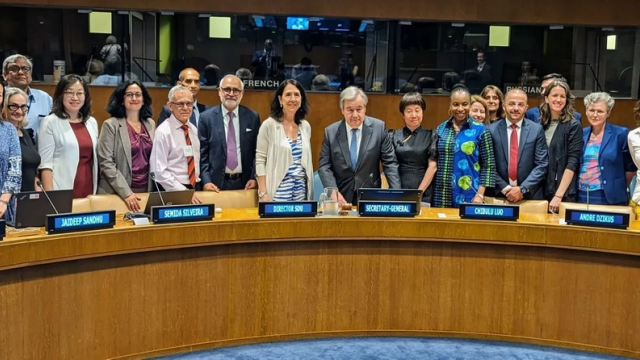The Council of Engineers for the Energy Transition Meets with the UN Secretary-General alongside the High-Level Political Forum on Sustainable Development
The Council of Engineers for the Energy Transition (CEET) held several events alongside the UN High Level Political Forum (HLPF), including official HLPF side events that discussed scaling the energy transition at the regional level and the technical opportunities and challenges of building a zero-carbon energy system; as well as a meeting with the UN Secretary General, António Guterres.
The Council of Engineers for the Energy Transition convened in New York during the High-Level Political Forum on Sustainable Development this past week. Co-chaired by Jeffrey Sachs, the Council continued its discussions as to how the global energy sector will achieve net-zero emissions by 2050, as set forth by the Paris Climate Agreement. These discussions focused on how different regions and technologies play a part in the transition toward a net-zero economy. New and existing Council members met and convened ahead of COP28 to contribute to interregional and connected discussions as to how to best move forward on achieving a net-zero future. The work focused on technologies and pathways that would enable the scale-up of renewable energy and decarbonizing industrial activities.
The group began working with the United Nations Secretary-General on his call to:
- Disseminate scientific based assessments for key technologies and issues of decarbonization the global energy sector challenge,
- Identify cutting edge, bankable, technologies for carbon capture and storage, batteries, low-cost power generation, or all other applications,
- Specific technologies that are relevant to developing economies, with a focus on Africa,
- Work on cross border or regional scale systems, especially power systems, and
- Create opportunities for youth and the advancement of a just transition.
Particularly focusing on SDG 7 and SDG 9, the meetings focused on finding regional nuances in their progress towards a net-zero future while also acknowledging the similarities that intertwine global regions in the transition.
While it was acknowledged that the current progress is lagging behind the net zero by 2050 target, members were quick to point out that progress was still being made and the first step toward true progress is commitment to the goal in an international setting. Enthusiastic and concrete steps are still being taken to accomplish the goals set forth in the Paris Climate Agreement. Even with this acknowledgment, regional leaders proclaimed that “with no will, there is no way” in a positive proclamation of the continued efforts by regional leaders to attain a net-zero environment.
Emphasis was placed not just on furthering efforts of engineering strategies to achieve reductions in greenhouse gas emissions, but also on the equitable formulation of such a plan and recognizing the different contexts of the various regions. Continued efforts were seen not just in terms of technological developments and ambitions, but also for equal voices throughout the regional groups.
On the second day, the first order of business was ensuring not only technological understanding but also continued input by all stakeholders in the process. The goal of these working groups is interconnectedness and collaboration, and that was emphasized throughout these discussions. Progress was made to ensure consistent language was understood throughout the working groups, and to focus the regional groups on the technological difficulties of the specific regions rather than getting bogged down by politically or socially divisive language that can plague efficient discussion.
The role of these working groups is to inform both United Nations divisions as well as institutional lenders of the opportunities and success stories of various technologies in the regions. These roles are not solely internalized to regional groups, but are also meant to:
- Encourage international cooperation,
- Find similarities and differences between regions that can influence funding and project financing,
- Provide focus that aids financial initiatives for region-specific programs,
- Unlock knowledge and technology sharing that lifts all regions above their current status quo, and
- Create a standard of policy that promotes global agendas without overemphasizing regional roles while downloading other regional initiatives.
Other conversations included dialogues on hydrogen energy, the role of natural gas for regions that are still developing, clean cooking fuels, and digitalization. There will be continued conversation on best practices to reduce emissions in transportation and industries, such as steel and iron, as well as various other industries. Other central emphases in the decarbonization strategy will continue to be addressed in future meetings before COP28 in December.
These meetings represent a dialogue meant to be representative of the collaboration, communication, and interconnectedness that is required for a net-zero transition. Without both championing the unique perspectives of different regions or recognizing the differences between regions, progress will be difficult if not impossible to attain. Therefore, the Council of Engineers on the Energy Transition is not only important in its own right, but also indicative of the interconnectedness required by the world as a whole to bring about a timely, efficient, and just energy transition toward a net-zero future that is envisioned by the United Nations.
